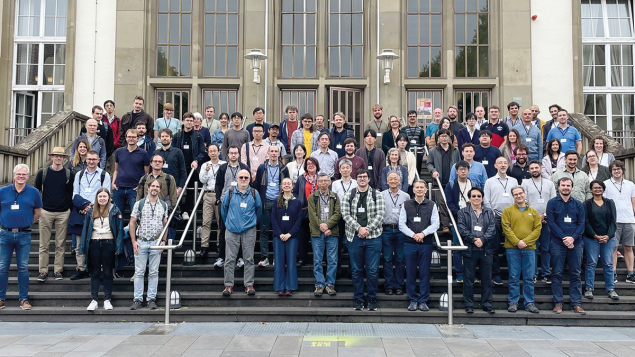Independent cross-checks Kaon physics is in a particularly dynamic phase. Credit: Kaons 2025
The 13th KAONS conference convened almost 100 physicists in Mainz from 8 to 12 September. Since the first edition took place in Vancouver in 1988, the conference series has returned roughly every three years to bring together the global kaon-physics community. This edition was particularly significant, being the first since the decision not to continue CERN’s kaon programme with the proposed HIKE experiment (CERN Courier May/June 2024 p7).
CERN’s current NA62 effort was nevertheless present in force. Eight presentations spanned its wide-ranging programme, from precision studies of rare kaon decays to searches for lepton-flavour and lepton-number violation, and explorations beyond the Standard Model (SM). Complementary perspectives came from Japan’s KOTO experiment at J-PARC, from multipurpose facilities such as KLOE-2, Belle II and CERN’s LHCb experiment, as well as from a large and engaged theoretical community. Together, these contributions underscored the vitality of kaon physics: a field that continues to test the SM at the highest levels of precision, with a strong potential to uncover new physics.
NA62 reported a big success on the so-called “golden mode” ultra-rare decay K+ → π+νν, a process that is highly sensitive to new physics (CERN Courier July/August 2024 p30). NA62 has already delivered remarkable progress in this domain: by analysing data up to 2022, the collaboration more than doubled its sample from 20 to 51 candidate events, achieving the first 5σ observation of the decay (CERN Courier November/December 2024 p11). This is the smallest branching fraction ever measured, and, intriguingly, shows a mild 1.7σ tension with the Standard Model prediction, which itself is known with a 2% theoretical uncertainty. With the experiment continuing to collect data until CERN’s next long shutdown (LS3), NA62’s final dataset is expected to triple the current statistics, sharpening what is already one of the most stringent tests of the SM.
Another major theme was the study of rare B-meson decays where kaons often appear in the final state, for example B → K* (→ Kπ) ℓ+ℓ–. Such processes are central to the long-debated “B anomalies,” in which certain branching fractions of rare semileptonic B decays show persistent tensions between experimental results and SM predictions (CERN Courier January/February 2025 p14). On the experimental front, CERN’s LHCb experiment continues to lead the field, delivering branching-fraction measurements with unprecedented precision. Progress is also being made on the theoretical side, though significant challenges remain in matching this precision. The conference highlighted new approaches reducing uncertainties and biases, based both on phenomenological techniques and lattice QCD.
Kaon physics is in a particularly dynamic phase. Theoretical predictions are reaching unprecedented precision, and two dedicated experiments are pushing the frontiers of rare kaon decays. At CERN, NA62 continues to deliver impactful results, even though plans for a next-stage European successor did not advance this year. Momentum is building in Japan, where the proposed KOTO-II upgrade, if approved, would secure the long-term future of the programme. Just after the conference, the KOTO-II collaboration held its first in-person meeting, bringing together members from both KOTO and NA62 – a promising sign for continued cross-fertilisation. Looking ahead, sustaining two complementary experimental efforts remains highly desirable: independent cross-checks and diversified systematics. Both will be essential to fully exploit the discovery potential of rare kaon decays.


